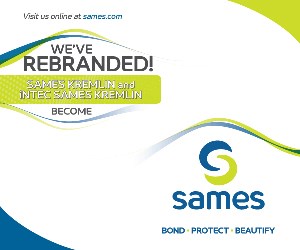Share
Q: I run a small powder coating operation and we are seeing an increase in uneven build thickness and texture defects. What is causing this, and how can we fix it?
A: One of the most common quality issues with powder coating is an “orange peel” effect. Orange peeling is defined as an uneven texture on smooth finish products. It resembles the skin of citrus fruit, hence the orange peel name. The level of orange peel is visually determined by comparing to industry standards, typically the Powder Coating Institute (PCI) smoothness standard grading chart. The expectations for what level of orange peel is acceptable will vary by product.
Many things can cause orange peel defects. Here’s a list of common possible caused and what you can try to fix them:
- The heat up cycle of your parts is too slow. In this case, determine the heat up curve and increase accordingly. Parts with high wall thickness are especially susceptible.
- Your substrate temperature exceeds the melt temperature, causing excessive film build. Try checking the substrate temperature (maximum should be 40ºC/104ºF). If it’s higher than the melt temperature, increase the cool down phase.
- There has been a shift in particle size distribution and the portion of your reclaimed powder is too high. To fix, optimize deposit results of powder guns or increase lift intervals.
- Your film thickness is too high or too low. Check system parameters to determine whether this is the case.
- The powder coatings being used are incompatible. Check the booth and consult the powder manufacturer to ensure this is not the case.
- The powder has been store too long or it has pre-reacted. To fix this, check the storage time. If powder is too old, exchange with fresher powder.
- The voltage you’re using is too high. To fix this, optimize the voltage or change to low ionizing applications or tribo guns. Tribo guns charge particles by frictional contact with material inside the gun body, as opposed to the more widely used corona charging, which uses the power supply to charge particles. Tribo charging provides excellent faraday cage application.
- You’re seeing uneven wall thickness. To correct, optimize the oven temperature.
- You’re experiencing back ionization effect. Try reducing the voltage or increase the distance between the workpiece and the gun.
- The airspeed at the oven entrance could be too high. In this case, reduce airspeed (it should be no more than 0.5m/sec or 1.5 ft/sec) or change air flow guides.
- Parts are too hot when coming from the dry-off oven. Try allowing a longer cooler time (less than 40ºC/104ºF for parts.
- The preheat temperature is too high. This can be corrected by lowering the preheat temperature or allowing more time for cooling.
- The powder flow is too high. To correct, lower the powder feed.
- The coating time is too long. To correct, lower the coating time.
- The part geometry is difficult or unfavorable. In this case, try changing the hanging or gun configuration.
- The gun and part are too close together. Try increasing the gun-to-part distance.
After curing, it is important to always complete a visual check within the standard film thickness and compare it to the master panel of the finished product. Make sure it follows the PCI smoothness standards as a guideline.
Related Content
How to Maximize Nickel Plating Performance
The advantages of boric acid-free nickel plating include allowing manufacturers who utilize nickel plating to keep up the ever-changing regulatory policies and support sustainability efforts.
Read MoreAn Overview of Electroless Nickel Plating
By definition, electroless plating is metal deposition by a controlled chemical reaction.
Read MoreTop Reasons to Switch to a Better Cleaning Fluid
Venesia Hurtubise from MicroCare says switching to the new modern cleaning fluids will have a positive impact on your cleaning process.
Read MoreAnodizing for Bonding Applications in Aerospace
Anodizing for pre-prep bonding bridges the gap between metallic and composite worlds, as it provides a superior surface in many applications on aluminum components for bonding to these composites.
Read MoreRead Next
Education Bringing Cleaning to Machining
Debuting new speakers and cleaning technology content during this half-day workshop co-located with IMTS 2024.
Read More















